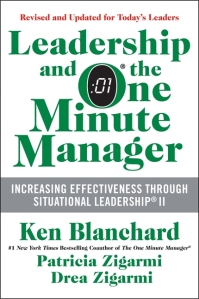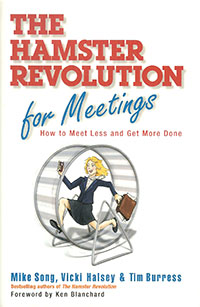 HarperCollins just released our revised edition of Leadership and the One Minute Manager. Much has changed since the original book was published nearly 30 years ago—workforces are more diverse, workplaces are less centralized, and technology has revolutionized business communications. Surprisingly, much has remained the same, especially when it comes to managing people. Today more than ever leaders have to do three important things. First, they have to help people set clear goals. Second, they have to diagnose people’s development level on each task. Third, they have to match their leadership style to the development level of the person they’re leading, to provide that person with what they need to succeed.
HarperCollins just released our revised edition of Leadership and the One Minute Manager. Much has changed since the original book was published nearly 30 years ago—workforces are more diverse, workplaces are less centralized, and technology has revolutionized business communications. Surprisingly, much has remained the same, especially when it comes to managing people. Today more than ever leaders have to do three important things. First, they have to help people set clear goals. Second, they have to diagnose people’s development level on each task. Third, they have to match their leadership style to the development level of the person they’re leading, to provide that person with what they need to succeed.
Notice I said “diagnose people’s development level on each task.” Even among experienced managers, it’s easy to fall into a trap of seeing people as beginners, or moderately competent, or highly experienced. When we paint people with a broad brush—for example, assuming that because a person is an expert in one aspect of their job, they’re an expert in all aspects of their job—our assumptions often lead to misunderstandings and poor performance.
If you’re anything like me, there are parts of your job you’re good at, but there are also aspects of your job where you’re still learning—especially in today’s constantly changing business environment. Mastering a new technology is the one example most people can relate to. Just about all of us know what it feels like to be a beginner when confronted with a new technological advance.
For any particular task, people can be at one of four development levels, depending on their experience and commitment. Your job as a leader is to identify and understand those different levels and adjust your level of direction and support accordingly. Here’s a brief overview:
Development Level One – Enthusiastic Beginner. Appropriate Leadership Style: Directing
An enthusiastic beginner is eager to get started on a task, even though they do not have any demonstrated expertise. For this task, regardless of the overall tenure of the employee, the leader needs to provide specific direction about goals, show and tell how, and closely monitor the individual’s performance in order to provide frequent feedback on results.
Development Level Two – Disillusioned Learner. Appropriate Leadership Style: Coaching
This development level usually sets in after an employee has been unsuccessful on a new task. The leader needs to direct goal or task accomplishment but also explain why, solicit suggestions, and begin to encourage involvement in decision making.
Development Level Three – Capable But Cautious Performer. Appropriate Leadership Style: Supporting
Once a person has demonstrated skill with a task, the leader and the individual make decisions together. The role of the leader is to facilitate, listen, draw out, encourage, and support.
Development Level Four – Self Reliant Achiever. Appropriate Leadership Style: Delegating
Once an individual becomes an expert at a task, the leader allows the individual to make most of the decisions about what, how, and when. The role of the leader is to value the individual’s contributions and support his or her growth.
It’s easy for us to stereotype people as beginners, moderates, or seasoned veterans in all of their tasks, despite knowing from our own experience that we’re often at very different levels of competence and commitment on our own tasks. Even seasoned managers can fall into this broad brush approach. Take an extra minute with your people to diagnose their development level on each of their goal-related tasks. A little extra time up front will pay dividends and save time down the road.
Read more http://howwelead.org/2013/10/30/dont-be-a-one-dimensional-leader-adjust-your-style-to-the-task/






